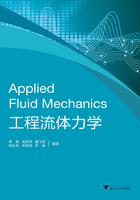
Chapter 4 Fundamental equations of steady total flow
§4.1 Analysis method of total flow
In actual flow, even the simplest flow, the velocity distribution at various points of its cross section is not uniform.Thus kinetic energy, momentum and pressure are also not uniform.In total flow analysis, using cross-section average method to process the physical quantities based on the element flow.
4.1.1 Element flow, total flow and control cross section of total flow
1.Element flow and total flow
Element flow is mini-stream tube in flow cross-section.
If the walls of the stream tube are extended to the flow field boundary, the fluid flow within the boundary is the total flow.
In the analyses of the variation of motion parameters such as flow velocity, flow rate, pressure and so on, the total flow can be divided into countless mini-stream tube. The motion parameters at every point on section dA can be considered to be uniform due to the very small section of mini-stream tube, therefore the flow parameters of total flow can be obtained by the integral method.
2.Control cross section
The control cross section is a section that every area element in the section is normal to mini-stream tube or streamline.The control cross section is denoted as dA or A.Two control cross sectionm-m and c-c are given in Fig.4-1.

Fig.4-1 Control cross section
4.1.2 The analysis of total flow
1.Based on the element flow
The total flow is constituted by element flow.Thus, the movement of element flow is analysis at first, and then extended to the total flow.
2.Choose control cross section in gradually varied flow
In the analysis of total flow, the control section is taken in the gradually varied flow.The reasons are two characteristics of gradually varied flow.One is that cross- section is a flat.Another is that the velocity directions of each point are almost parallel.
Why not choosing rapidly varied flow? Case in pipe flow, cross-section is not a flat in rapidly varied flow.Besides, the velocity distribution in section is very uneven.
3.Physical quantities average of cross section
(1)Mean velocity of cross-section
The velocity at every point in the cross section is different and its distribution is a parabola.The velocity u takes the maximum umaxon the pipe axle and the zero on the boundary as shown in Fig.4-2.According to the equivalency of flow rate, the fluid volume that pass through a cross section A as an average v must be equal to the fluid volume passing through the section as an actual velocity in unit time, namely, there with


Fig.4-2 Mean velocity
(2)Momentum and correction coefficient of momentum
In words, for any direction the sum of variation of the momentum within a control volume plus the net outflow of momentum from the control volume is equal to the component of the resultant external force acting on a control volume at that direction in unit time.
For a steady flow of incompressible fluid, if the control surfaces, normal to the velocity wherever it cuts across the flow, have only the two surfaces, i.e.the outflow surface and the inflow surface, and if the velocities in the surfaces are uniform, the surface integral in Equation could be removed.It reduces to
d K=d m u=(ρu d A ·Δ t)u=ρu u d A ·Δ t

Leading into momentum correction factorβ, and definition as follow:

For incompressible constant flow, we have

(3)Kinetic energy and correction coefficient of kinetic energy
The kinetic energy is obj ect due to the motion of the mechanical energy.
The kinetic energy of micro cell area dA at unit of time is

For incompressible constant flow,

Leading into momentum correction factorα, and definition as follow:
